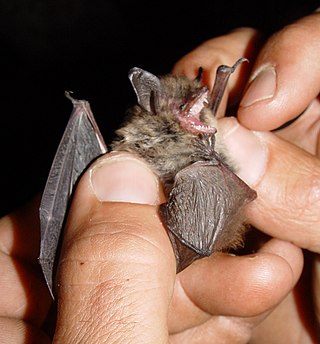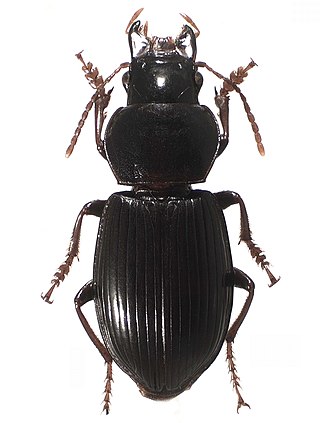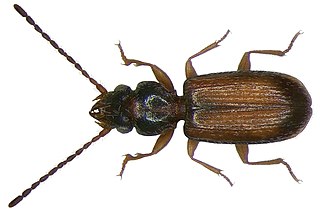
The mouse-eared bats or myotises are a diverse and widespread genus (Myotis) of bats within the family Vespertilionidae. The noun "myotis" itself is a Neo-Latin construction, from the Greek "muós and "oûs", literally translating to "mouse-eared".

The great evening bat is the largest bat in the vesper bat family (Vespertilionidae) and the only living species in the genus Ia. It is common to Eastern and Southeastern Asia, mainly living in areas with limestone caves at altitudes of 400–1,700 metres (0.25–1.06 mi). Their roost sites have been found both near the cave entrances and up to 1.5 kilometres (0.93 mi) within the cave systems.

Hodgson's bat, also called the copper-winged bat or black-and-orange myotis, is a species of vesper bat in the genus Myotis, the mouse-eared bats. Favouring mountain forests, it is found throughout Central, Southeast, and East Asia, from Afghanistan to Taiwan. It is about 5 centimetres (2.0 in) long and is distinguished from most other species of bat in this range by its yellowish colouration.

The harlequin bat is a species of bat in the family Vespertilionidae, the vesper bats. It is the only member of the genus Scotomanes.

The Hainan gymnure or Hainan moonrat is a species of mammal in the family Erinaceidae. Its natural habitat is subtropical or tropical dry forests. It was thought to be endemic to the island of Hainan, China, where it is threatened due to habitat loss, but in 2018 was found to also occur in, and be rather common, in Northern Vietnam.

The great roundleaf bat, also known as the great Himalayan leaf-nosed bat is a species of bat in the family Hipposideridae found in South Asia, Southeast Asia, and China. It gives birth to two young a year. It has been assessed as a least concern species by the IUCN.
Desera is a genus in the beetle family Carabidae. There are more than 20 described species in Desera.

Chydaeus is a genus of beetles in the family Carabidae. Members of this genus are distributed mainly over mountainous regions of southeastern Asia, from the Himalayas and China to the Sunda Islands; however, three species are known from New Guinea and one from Australia.
Coleolissus is a genus in the beetle family Carabidae. There are more than 50 described species in Coleolissus, found in Asia.

Pericalus is a genus in the beetle family Carabidae. There are at least 40 described species in Pericalus, found in the south, southeast, and east of Asia.

Dasiosoma is a genus in the beetle family Carabidae. There are about 10 described species in Dasiosoma.

Lachnoderma is a genus in the beetle family Carabidae. There are about 14 described species in Lachnoderma.

Pareuryaptus is a genus in the beetle family Carabidae. There are about 19 described species in Pareuryaptus, found mainly in Southeast Asia.

Trigonotoma is a genus in the beetle family Carabidae. There are more than 50 described species in Trigonotoma.

Perileptus is a genus in the beetle family Carabidae. There are more than 50 described species in Perileptus.

The grand roundleaf bat, also known as the grand leaf-nosed bat, is a species of bat in the genus Hipposideros. It can be found in China, Myanmar, Thailand, and Vietnam.

Orionella is a genus of beetle in the family Carabidae, with four known species as of April 2013:
The Taiwan broad-muzzled bat or Taiwan broad-muzzled myotis is a species of vesper bat found in Taiwan.
Submyotodon is a genus of vespertilionid bats, published as a new taxon in 2003 to describe a Miocene fossil species. Extant species and subspecies previously included in Myotis were later transferred to this genus. Species in this genus are referred to as broad-muzzled bats or broad-muzzled myotises.
Kerivoula depressa, commonly called Miller's flat-headed woolly bat or the flat-skulled woolly bat, is a species of vesper bat found in Southeast Asia.














